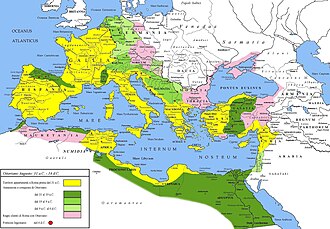Tuisto

According to Tacitus's Germania (AD 98), Tuisto (or Tuisco) is the legendary divine ancestor of the Germanic peoples. The figure remains the subject of some scholarly discussion, largely focused upon etymological connections and comparisons to figures in later (particularly Norse) Germanic mythology.
Etymology
The Germania manuscript corpus contains two primary variant readings of the name. The most frequently occurring, Tuisto, is commonly connected to the
The second variant of the name, occurring originally in manuscript E, reads Tuisco. One proposed etymology for this variant reconstructs a Proto-Germanic *tiwisko and connects this with Proto-Germanic *
Tuisto, Tvastar, and Ymir
Connections have been proposed between the 1st-century figure of Tuisto and the primeval being Ymir in later Norse mythology, attested in 13th-century sources, based upon etymological and functional similarity.[2][b] Meyer (1907) sees the connection as so strong, that he considers the two to be identical.[3] Lindow (2001), while mindful of the possible semantic connection between Tuisto and Ymir, notes an essential functional difference: while Ymir is portrayed as an "essentially ... negative figure" – Tuisto is described as being "celebrated" (celebrant) by the early Germanic peoples in song, with Tacitus reporting nothing negative about Tuisto.[4]
Jacob (2005) attempts to establish a genealogical relationship between Tuisto and Ymir based on etymology and a comparison with
Attestation
Tacitus relates that "ancient songs" (
Theories and interpretations

Tacitus's report falls squarely within the ethnographic tradition of the classical world, which often fused
According to Rives (1999), the fact that the ancient Germanic peoples claimed descent from an earth-born god was used by Tacitus to support his contention that they were an indigenous population: the Latin word indigena was often used in the same sense as the Greek autochthonos, meaning literally '[born from] the land itself'.[10] Lindauer (1975) notes that although this claim is to be judged as one made out of simple ignorance of the facts on the part of Tacitus, he was not entirely wrong, as he made the judgement based on a comparison with the relatively turbulent Mediterranean region of his day.[11]
The name Tuisto is also given as Tuitsch or Teutsch in its alternative versions and made to derive from the same founding figure called Tuisco (merely as alternate spellings of the same name)[12] who was claimed to have led the Germans from the incident of the Tower of Babel into Europe[13] and from whom the Germans themselves derived their name: Deutsch[14][15] and as a consequence that of their land.
Later influence
In 1498, a monk named
See also
- Ethnogenesis
- Tvashtar
- Loki
Notes
- ^ Claims of a connection between Tuisto and Teut and/or Teutones, or worse, the former and the Buddhist name Tat as proposed by Hargrave Jennings in his Indian Religions (1890; republished in 1996) are to be rejected as grand examples of pseudoscientific language comparison. Though rejected outright in scholarly journals even before full publication, Faber's ideas apparently gained a wide circulation. Cf. Valpy (1812):227.
- ^ Simek (1995:485) further connects Ymir to PIE *iemo- "twin" or "double", whence Sanskrit Yama, Italic Gemini. See also Jumis, Remus.
References
- ^ Lindauer (1975), p. 81. Grimm proposed nearly the same as early as 1875; see Grimm, Stallybrass (2004a), p. 344.
- ^ Simek (1995), p. 432.
- ^ Meyer (1907); referenced in North (1997), p. 269.
- ^ Lindow (2001), p. 296.
- ^ Jacob (2005), p. 232.
- ^ Tacitus (2000), at 2.13–15.
- ^ Lindauer (1975), pp. 80–81.
- ^ Simek (2007), p. 336.
- ^ Simek (2007), pp. 224–225.
- ^ Rives (1999), pp. 111–112.
- ^ Lindauer (1975), p. 80.
- ^ Kraus (2012), p. 135.
- ^ Parry (1996), p. 56.
- ^ Bonfiglio (2010), p. 111.
- ^ White (2007), p. 98.
- ^ Anderson, James. "The Most Ancient Kings of the Germans". Royal Genealogies. p. 442.
Bibliography
- Bonfiglio, Thomas Paul (2010). Mother Tongues and Nations: The Invention of the Native Speaker. De Gruyter. ISBN 9781934078266.
- Grimm, J.; trans. Stallybrass, James Steven. (2004a). ISBN 0-486-43546-6.
- Grimm, J.; trans. Stallybrass, James Steven. (2004b). ISBN 0-486-43549-0.
- Jacob, Alexander (2005). Ātman: A Reconstruction of the Solar Cosmology of the Indo-Europeans. Georg Olms. ISBN 3-487-12854-3.
- Lindauer, Josef (1975). Germania: Bericht über Germanien. Munich: Deutscher Taschenbuch. ISBN 3-423-09101-0.
- Lindow, John. (2001) Norse Mythology: A Guide to the Gods, Heroes, Rituals, and Beliefs. Oxford University Press.
- North, Richard (1997). Heathen Gods in Old English Literature. ISBN 0-521-55183-8.
- Parry, Graham (1996). The Trophies of Time: English Antiquarians of the Seventeenth Century. ISBN 9780191567155.
- Rawlinson, George (2000). The History of Herodotus.
- Simek, Rudolf (1995). Lexikon der germanischen Mythologie. Stuttgart: Kröner ISBN 3-520-36802-1.
- Simek, Rudolf (2007), trans. Hall, Angela Dictionary of Northern Mythology. ISBN 0-85991-513-1.
- Stuart, Duane R. (1916). Germania. New York: MacMillan Co. 1916.
- ISBN 0-19-815050-4.
- Tacitus; trans. Fuhrmann, Manfred (2000). De origine et situ Germanorum liber. Stuttgart: Reclam. ISBN 3-15-009391-0.
- Valpy, A. J. (March–June 1812). The Classical Journal, Vol. V. London: A. J. Valpy.
- White, Craig M. (2007). The Great German Nation: Origins and Destiny. AuthorHouse. ISBN 9781434325495.
- Kraus, Andreas (2012). Studien zur bayerischen Landesgeschitsschreibung in Mittelalter und Neuzeit (in German). Beck. ISBN 9783406107245..
